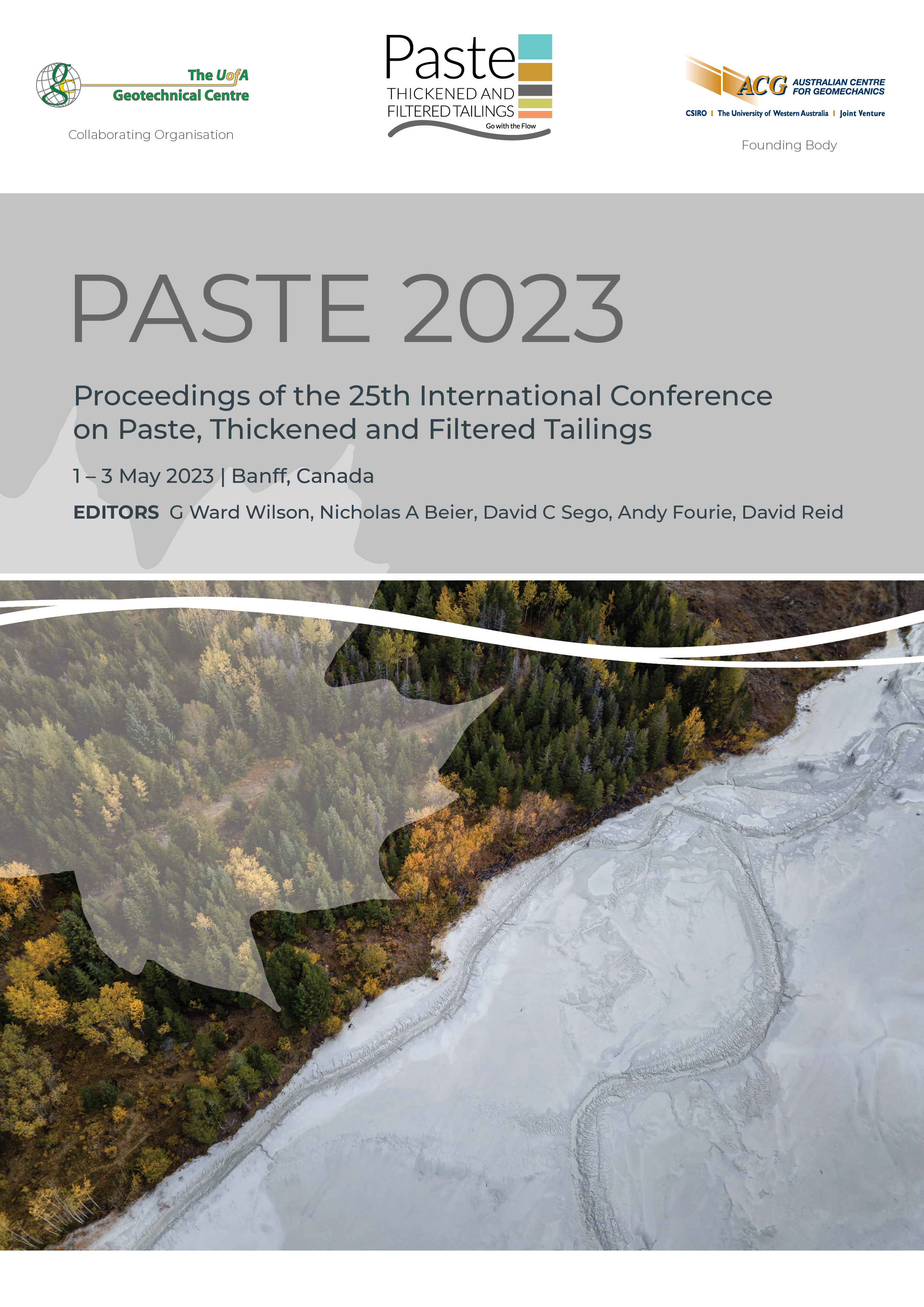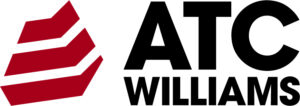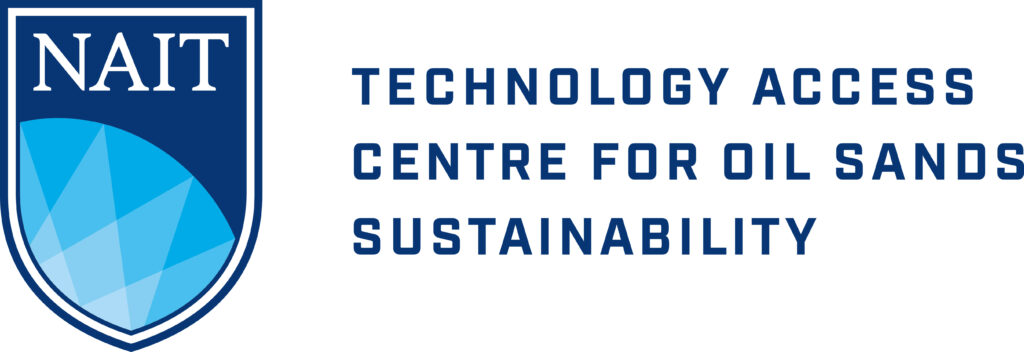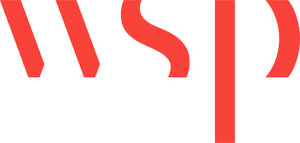A review of modern paste admixture technology and its effect on cement reduction in paste mix designs

|
Authors: Arcila Gut, S; Erismann, F; Ting, B |
DOI https://doi.org/10.36487/ACG_repo/2355_18
Cite As:
Arcila Gut, S, Erismann, F & Ting, B 2023, 'A review of modern paste admixture technology and its effect on cement reduction in paste mix designs', in GW Wilson, NA Beier, DC Sego, AB Fourie & D Reid (eds), Paste 2023: Proceedings of the 25th International Conference on Paste, Thickened and Filtered Tailings, University of Alberta, Edmonton, and Australian Centre for Geomechanics, Perth, pp. 244-256, https://doi.org/10.36487/ACG_repo/2355_18
Abstract:
The number of paste operations has grown since the early application of thickened tailings for backfill in the 1970s. Backfilling underground void stopes with paste is often a competitive backfill option compared to alternatives. Therefore, having suitable tailings is critical for paste backfill. Ideally, a paste system delivers a homogeneous, non-settling fluid with good flowability. Once placed, the paste should generate little bleed water and develop the required strength using the least amount of binder possible. The paste’s quality depends on the tailings’ properties, like mineralogical composition, related to the ore deposits’ geological evolution and formation. For example, epithermal gold systems are formed in a proximal volcanic setting and are triggered by an intense, hot, fluid migration process. This type of deposit has a different mineralogical footprint and alteration surrounding than an orogenic gold deposit, which experienced a different alteration and ore formation history, being formed along major fault zones. These differences, in addition to the required ore comminution processes, are reflected in the tailings produced from a given ore body and, therefore, impact the characteristics of the available tailings material to make a paste backfill product. Modern, state-of-the-art paste backfill admixtures are increasingly used to optimise paste backfill mix designs and to manage problematic tailings properties. This paper outlines the impact of using water-reducing admixtures on the solid content increase and strength gain of paste. Data from 13 different mine sites for three common deposit types – orogenic gold Iodes, VMS-SEDEX deposits, and epithermal deposits – have been collected for this study. Special attention is given to the impact of their particle size and their phyllosilicate content on the water-reducing potential and strength.
Keywords: paste backfill, particle size distribution, mineralogy, admixtures, optimisation
References:
Aitcin, PC & Wilson, W 2015, ‘The sky’s the limit’, Concrete International, vol. 37, no. 1, pp. 45-50.
Buchanan, LJ 1981, ‘Precious metal deposits associated with volcanic environments in the Southwest’, in WR Dickinson & WD Payne, (eds), ‘Relations of tectonics to ore deposits in the Southern Cordillera’, Arizona Geological Society Digest, vol. 14, pp. 237-262.
Calvo, G, Mudd, G & Valero, A 2016, ‘Decreasing ore grades in global metallic mining: A theoretical issue or a global reality?’, vol. 5, no.4, article no. 36,
Erismann, F, Kurz, C & Hansson, M 2016, ‘The benefits of incorporating admixtures into mine paste backfill’, in Proceedings of the 19th International Seminar on Paste and Thickened Tailings, Gecamin, Santiago, pp. 76–86.
Erismann, F & Hannson, M 2021, ‘Efficient paste mix designs using new generation backfill admixtures – Perception versus reality’, in F, Hassani, J, Palarski, Sokoła-Sziewioła & G, Strozik (eds), Minefill 2020-2021, CRC Press, Leiden, pp. 3-12.
Hedenquist, J & Arribas, A 2000, ‘Exploration for epithermal gold deposits’, in SG Hagemann & PE Brown (eds), Gold in 2000, vol. 13, Society of Economic Geologists, Boulder, pp. 245-277,
Hannington, MD, Bleeker, W & Kjarsgaard, I 1998, ‘Sulfide mineralogy, geochemistry, and ore genesis of the Kidd Creek deposit, part I: North, central and south orebodies’, Economic Geology Monograph, vol 10, Society of Economic Geologists, Boulder,
Mahasenan, N, Smith, S & Humphreys, K 2003, ‘The cement industry and global climate change: Current and potential future cement industry CO2 emissions’, Proceedings of the 6th International Conference on Greenhouse Gas Control Technologies, Kyoto, Japan, vol. 2, pp. 995-1000,
McKibben, MA, Hardie, LA & Barnes, LA 1997, ‘Ore-forming brines in active continental rifts’, in HL Barnes (ed.), Geochemistry of Hydrothermal Ore Deposits, John Wiley & Sons, Hoboken, pp. 877–935.
Palma, A, Urra, C, Gonzalo, C & Maldonado, P 2016, ‘Study of mineralogical properties that affect the process of thickened tailings: Project Talabre thickened tailings’, in Proceedings of the 19th International Seminar on Paste and Thickened Tailings, Gecamin, Santiago, pp. 29-39.
Ramachandran, VS, Malhotra, VM, Jolicoeur, C & Spiratos, N 1998, Superplasticizers: Properties and Applications in Concrete, Materials Technology Laboratory, CANMET, Ottawa.
Pashias, N, Boger, J, Summers, DV, & Glenister, DJ 1996, ‘A fifty cent rheometer for yield stress measurement’, Journal of Rheology, vol. 40, no. 6, pp. 1179-1189.
Sillitoe, RH 1994, ‘Erosion and collapse of volcanoes: Causes of telescoping in intrusion-centered ore deposits’, Geology, vol. 22, no. 10, pp. 945–948. ;2
Silva, M 2017, Contribution to Laboratorial Determination of Rheological Properties of Paste Backfill, Zinkgruvan and Neves-Corvo Case Studies, MSc Thesis, Technico Lisboa, Lisbon.
Sofra, F 2017, ‘Rheological properties of fresh cemented paste tailings’, in E Yilmaz & M Fall (eds), Paste Tailings Management, Springer, Cham, pp. 33-57,
Stone, D 2021, Module 1 –Backfill selection, mine backfill workshop, course notes, pp. 1-33, 13th International Symposium on Mining with Backfill, Gliwice.
ASTM International 2006, Standard Test Method for Unconfined Compressive Strength of Cohesive Soil (ASTM D2166-06), ASTM International, West Conshohocken.
ASTM International 2019, Standard Practice for Laboratory Determination of Water (Moisture) Content of Soil and Rock by Mass (ASTM D2216-19), ASTM International, West Conshohocken.
ASTM International 2022, Standard Practice for Making and Curing Concrete Test Specimens in the Field (ASTM C31/C31M-03a), ASTM International, West Conshohocken.
© Copyright 2024, Australian Centre for Geomechanics (ACG), The University of Western Australia. All rights reserved.
View copyright/legal information
Please direct any queries or error reports to repository-acg@uwa.edu.au
View copyright/legal information
Please direct any queries or error reports to repository-acg@uwa.edu.au



